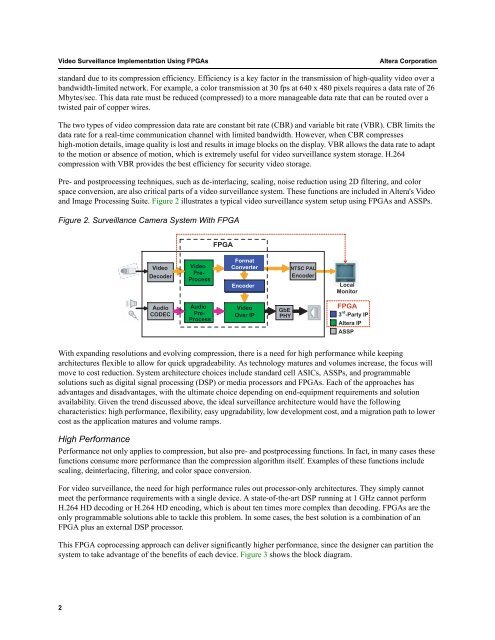Video Surveillance Implementation Using FPGAs - Altera
Video Surveillance Implementation Using FPGAs - Altera
Video Surveillance Implementation Using FPGAs - Altera
You also want an ePaper? Increase the reach of your titles
YUMPU automatically turns print PDFs into web optimized ePapers that Google loves.
<strong>Video</strong> <strong>Surveillance</strong> <strong>Implementation</strong> <strong>Using</strong> <strong>FPGAs</strong> <strong>Altera</strong> Corporation<br />
standard due to its compression efficiency. Efficiency is a key factor in the transmission of high-quality video over a<br />
bandwidth-limited network. For example, a color transmission at 30 fps at 640 x 480 pixels requires a data rate of 26<br />
Mbytes/sec. This data rate must be reduced (compressed) to a more manageable data rate that can be routed over a<br />
twisted pair of copper wires.<br />
The two types of video compression data rate are constant bit rate (CBR) and variable bit rate (VBR). CBR limits the<br />
data rate for a real-time communication channel with limited bandwidth. However, when CBR compresses<br />
high-motion details, image quality is lost and results in image blocks on the display. VBR allows the data rate to adapt<br />
to the motion or absence of motion, which is extremely useful for video surveillance system storage. H.264<br />
compression with VBR provides the best efficiency for security video storage.<br />
Pre- and postprocessing techniques, such as de-interlacing, scaling, noise reduction using 2D filtering, and color<br />
space conversion, are also critical parts of a video surveillance system. These functions are included in <strong>Altera</strong>'s <strong>Video</strong><br />
and Image Processing Suite. Figure 2 illustrates a typical video surveillance system setup using <strong>FPGAs</strong> and ASSPs.<br />
Figure 2. <strong>Surveillance</strong> Camera System With FPGA<br />
With expanding resolutions and evolving compression, there is a need for high performance while keeping<br />
architectures flexible to allow for quick upgradeability. As technology matures and volumes increase, the focus will<br />
move to cost reduction. System architecture choices include standard cell ASICs, ASSPs, and programmable<br />
solutions such as digital signal processing (DSP) or media processors and <strong>FPGAs</strong>. Each of the approaches has<br />
advantages and disadvantages, with the ultimate choice depending on end-equipment requirements and solution<br />
availability. Given the trend discussed above, the ideal surveillance architecture would have the following<br />
characteristics: high performance, flexibility, easy upgradability, low development cost, and a migration path to lower<br />
cost as the application matures and volume ramps.<br />
High Performance<br />
Performance not only applies to compression, but also pre- and postprocessing functions. In fact, in many cases these<br />
functions consume more performance than the compression algorithm itself. Examples of these functions include<br />
scaling, deinterlacing, filtering, and color space conversion.<br />
For video surveillance, the need for high performance rules out processor-only architectures. They simply cannot<br />
meet the performance requirements with a single device. A state-of-the-art DSP running at 1 GHz cannot perform<br />
H.264 HD decoding or H.264 HD encoding, which is about ten times more complex than decoding. <strong>FPGAs</strong> are the<br />
only programmable solutions able to tackle this problem. In some cases, the best solution is a combination of an<br />
FPGA plus an external DSP processor.<br />
This FPGA coprocessing approach can deliver significantly higher performance, since the designer can partition the<br />
system to take advantage of the benefits of each device. Figure 3 shows the block diagram.<br />
2<br />
<strong>Video</strong><br />
Decoder<br />
Audio<br />
CODEC<br />
<strong>Video</strong><br />
Pre-<br />
Process<br />
Audio<br />
Pre-<br />
Process<br />
FPGA<br />
Format<br />
Converter<br />
Encoder<br />
<strong>Video</strong><br />
Over IP<br />
GbE<br />
PHY<br />
NTSC PAL<br />
Encoder<br />
Local<br />
Monitor<br />
3 rd FPGA<br />
-Party IP<br />
<strong>Altera</strong> IP<br />
ASSP
















